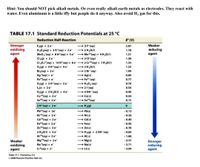
Chemistry
10th Edition
ISBN: 9781305957404
Author: Steven S. Zumdahl, Susan A. Zumdahl, Donald J. DeCoste
Publisher: Cengage Learning
expand_more
expand_more
format_list_bulleted
Question
Can you help me with this?

Transcribed Image Text:Hint: You should NOT pick alkali metals. Or even really alkali earth metals as electrodes. They react with
water. Even aluminum is a little iffy but people do it anyway. Also avoid H, gas for this.
TABLE 17.1 Standard Reduction Potentials at 25 °C
Reduction Half-Reaction
E (V)
Flg) + 2e-
H,0,(aq) + 2H (aq) + 2 e
Mnolog) + 8 H (ag) + 5e
Weaker
Stronger
oxidizing
agent
+2F(aq)
2.87
reducing
2H,01)
+ Mn"(aq) + 4H,0(1)
2 CI(og)
1.78
1.51
agent
Clg) + 2e
1.36
Cr,0,7(aq) + 14 H"(aq) + 6e-2 Cr "lag) + 7 H,0(1)
O,lg) + 4H (aq) + 4e
Bralaq) + 2e
Ag *(og) + e
Fe"(aq) + e
Olg) + 2H (aq) + 2e
Ils) + 2e
O,l9) + 2H,0() + 4e
Cu"(aq) + 2e
Sn*(aq) + 2e
1.33
+2H,01)
1.23
+2 Br (aq)
Ag(s)
Fe (aq)
H,02 (aq)
2r(aq)
1.09
0.80
0.77
0.70
0.54
4 OH (ag)
Cul s)
- Sn*laq)
0.40
0.34
0.15
2H (aq) + 2 e
(6)H+
Pb(s)
Pb"laq) + 2e"
Ni *(aq) + 2e
Cd"(aq) + 2e
Fe(ag) + 2e
Zn"laq) + 2e
2H,0() + 2e
AI"(aq) + 3e
Mg"laq) + 2e
Na *(ag) + e
Li*(aq) + e
- 0.13
+ Ni( s)
+ Cd(s)
+ Fe(s)
- 0.26
-0.40
- 0.45
- 0.76
(b0) HOZ + (6•
- 0.83
Zn(s)
+ Al( s)
+ Mg(s)
+ Na( s)
Li(s)
• 1.66
- 2.37
- 2.71
- 3.04
Weaker
oxidizing
agent
Stronger
reducing
agent
Table 17-1 Chemistry, S/e
0 2008 Pearson Prentice Hall, Inc.
![1. Examine this Titration Curve:
a. Suppose this is a titration curve for the titration of a strong acid (analyte) with a strong base
(titrant). The equivalence point is reached in the experiment when exactly 50.00 mL of the base
is used. Label each axis. Then label the equivalence point on the curve (dot). Finally, add values
on both axes that correspond to the equivalence point.
b. Suppose the acid solution used in part (a) was more concentrated than the base that was used.
This means that the volume of acid used must have been [less than; equal to; greater than] 100
milliliters.
с.
Write a net ionic equation for the reaction taking place in the flask below the buret.
d. In a separate but related experiment with the same reactants, suppose 25.0 mL of 0.500 M HA
and 3.0 mL of 0.800 M(OH) react. What is the pH of the final solution?
In a separate but related experiment with the same reactants, suppose 25.0 mL of 0.500 M HA
and 25.0 mL of 0.800 M(OH) react. What is the pH of the final solution?
е.](https://content.bartleby.com/qna-images/question/310fa1be-a638-47b3-9316-1b971054d314/94cf6a52-e3cd-4365-84df-5b5241eec5bd/esxghon_thumbnail.jpeg)
Transcribed Image Text:1. Examine this Titration Curve:
a. Suppose this is a titration curve for the titration of a strong acid (analyte) with a strong base
(titrant). The equivalence point is reached in the experiment when exactly 50.00 mL of the base
is used. Label each axis. Then label the equivalence point on the curve (dot). Finally, add values
on both axes that correspond to the equivalence point.
b. Suppose the acid solution used in part (a) was more concentrated than the base that was used.
This means that the volume of acid used must have been [less than; equal to; greater than] 100
milliliters.
с.
Write a net ionic equation for the reaction taking place in the flask below the buret.
d. In a separate but related experiment with the same reactants, suppose 25.0 mL of 0.500 M HA
and 3.0 mL of 0.800 M(OH) react. What is the pH of the final solution?
In a separate but related experiment with the same reactants, suppose 25.0 mL of 0.500 M HA
and 25.0 mL of 0.800 M(OH) react. What is the pH of the final solution?
е.
Expert Solution
This question has been solved!
Explore an expertly crafted, step-by-step solution for a thorough understanding of key concepts.
Step by stepSolved in 2 steps with 1 images

Knowledge Booster
Learn more about
Need a deep-dive on the concept behind this application? Look no further. Learn more about this topic, chemistry and related others by exploring similar questions and additional content below.Similar questions
arrow_back_ios
SEE MORE QUESTIONS
arrow_forward_ios
Recommended textbooks for you
 ChemistryChemistryISBN:9781305957404Author:Steven S. Zumdahl, Susan A. Zumdahl, Donald J. DeCostePublisher:Cengage Learning
ChemistryChemistryISBN:9781305957404Author:Steven S. Zumdahl, Susan A. Zumdahl, Donald J. DeCostePublisher:Cengage Learning ChemistryChemistryISBN:9781259911156Author:Raymond Chang Dr., Jason Overby ProfessorPublisher:McGraw-Hill Education
ChemistryChemistryISBN:9781259911156Author:Raymond Chang Dr., Jason Overby ProfessorPublisher:McGraw-Hill Education Principles of Instrumental AnalysisChemistryISBN:9781305577213Author:Douglas A. Skoog, F. James Holler, Stanley R. CrouchPublisher:Cengage Learning
Principles of Instrumental AnalysisChemistryISBN:9781305577213Author:Douglas A. Skoog, F. James Holler, Stanley R. CrouchPublisher:Cengage Learning Organic ChemistryChemistryISBN:9780078021558Author:Janice Gorzynski Smith Dr.Publisher:McGraw-Hill Education
Organic ChemistryChemistryISBN:9780078021558Author:Janice Gorzynski Smith Dr.Publisher:McGraw-Hill Education Chemistry: Principles and ReactionsChemistryISBN:9781305079373Author:William L. Masterton, Cecile N. HurleyPublisher:Cengage Learning
Chemistry: Principles and ReactionsChemistryISBN:9781305079373Author:William L. Masterton, Cecile N. HurleyPublisher:Cengage Learning Elementary Principles of Chemical Processes, Bind...ChemistryISBN:9781118431221Author:Richard M. Felder, Ronald W. Rousseau, Lisa G. BullardPublisher:WILEY
Elementary Principles of Chemical Processes, Bind...ChemistryISBN:9781118431221Author:Richard M. Felder, Ronald W. Rousseau, Lisa G. BullardPublisher:WILEY

Chemistry
Chemistry
ISBN:9781305957404
Author:Steven S. Zumdahl, Susan A. Zumdahl, Donald J. DeCoste
Publisher:Cengage Learning

Chemistry
Chemistry
ISBN:9781259911156
Author:Raymond Chang Dr., Jason Overby Professor
Publisher:McGraw-Hill Education

Principles of Instrumental Analysis
Chemistry
ISBN:9781305577213
Author:Douglas A. Skoog, F. James Holler, Stanley R. Crouch
Publisher:Cengage Learning

Organic Chemistry
Chemistry
ISBN:9780078021558
Author:Janice Gorzynski Smith Dr.
Publisher:McGraw-Hill Education

Chemistry: Principles and Reactions
Chemistry
ISBN:9781305079373
Author:William L. Masterton, Cecile N. Hurley
Publisher:Cengage Learning

Elementary Principles of Chemical Processes, Bind...
Chemistry
ISBN:9781118431221
Author:Richard M. Felder, Ronald W. Rousseau, Lisa G. Bullard
Publisher:WILEY